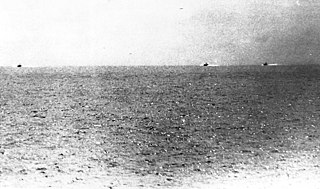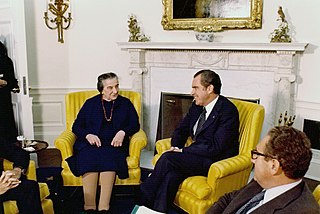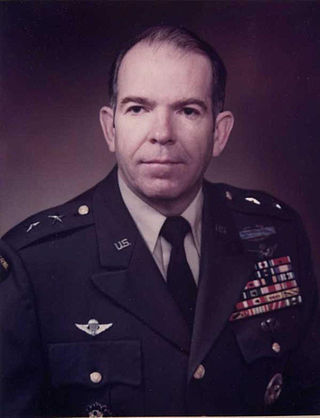
Agent Orange is a chemical herbicide and defoliant, one of the tactical use Rainbow Herbicides.

The People's Army of Vietnam (PAVN), officially the Vietnam People's Army, also recognized as the Vietnamese Army or the People's Army, is the national military force of the Socialist Republic of Vietnam and the armed wing of the ruling Communist Party of Vietnam (CPV). The PAVN is a part of the Vietnam People's Armed Forces and includes: Ground Force, Navy, Air Force, Border Guard and Coast Guard. Vietnam does not have a separate Ground Force or Army service. All ground troops, army corps, military districts and special forces belong to the Ministry of National Defence, directly under the command of the CPV Central Military Commission, the Minister of National Defence, and the General Staff of the Vietnam People's Army. The military flag of the PAVN is the National flag of the Socialist Republic of Vietnam defaced with the motto Quyết thắng added in yellow at the top left.

The Gulf of Tonkin incident was an international confrontation that led to the United States engaging more directly in the Vietnam War. It consisted of a confrontation on August 2, 1964, when United States forces were carrying out covert amphibious operations close to North Vietnamese territorial waters, which triggered a response from North Vietnamese forces. The United States government falsely claimed that a second incident occurred on August 4, 1964, between North Vietnamese and United States ships in the waters of the Gulf of Tonkin. Originally, US military claims blamed North Vietnam for the confrontation and the ostensible, but in fact imaginary, incident on August 4. Later investigation revealed that the second attack never happened. The official American claim is that it was based mostly on erroneously interpreted communications intercepts. The National Security Agency, an agency of the US Defense Department, had deliberately skewed intelligence to create the impression that an attack had been carried out.

William Childs Westmoreland was a United States Army general, most notable commander of United States forces during the Vietnam War from 1964 to 1968. He served as Chief of Staff of the United States Army from 1968 to 1972.

Melvin Robert Laird Jr. was an American politician, writer and statesman. He was a U.S. congressman from Wisconsin from 1953 to 1969 before serving as Secretary of Defense from 1969 to 1973 under President Richard Nixon. Laird was instrumental in forming the administration's policy of withdrawing U.S. soldiers from the Vietnam War; he coined the expression "Vietnamization," referring to the process of transferring more responsibility for combat to the South Vietnamese forces. First elected in 1952, Laird was the last living Representative elected to the 83rd Congress at the time of his death.

The Nixon Doctrine was the foreign policy doctrine of Richard Nixon, the 37th president of the United States from 1969 to 1974. It was put forth during a press conference in Guam on July 25, 1969, by Nixon, and later formalized in his speech on Vietnamization on November 3, 1969.

The 101st Airborne Division (Air Assault) ("Screaming Eagles") is a light infantry division of the United States Army that specializes in air assault operations. It can plan, coordinate, and execute multiple battalion-size air assault operations to seize terrain. These operations can be conducted by mobile teams covering large distances, fighting behind enemy lines, and working in austere environments with limited or degraded infrastructure. It was active in, for example, foreign internal defense and counterterrorism operations in Iraq, in Afghanistan in 2015–2016, and in Syria, as part of Operation Inherent Resolve in 2018–2021.

Maxwell Davenport Taylor was a senior United States Army officer and diplomat of the mid-20th century. He served with distinction in World War II, most notably as commander of the 101st Airborne Division, nicknamed "The Screaming Eagles."
A Military Assistance Advisory Group (MAAG) is a designation for a group of United States military advisors sent to other countries to assist in the training of conventional armed forces and facilitate military aid. Although numerous MAAGs operated around the world throughout the 1940s–1970s, including in Yugoslavia after 1951, and to the Ethiopian Armed Forces, the most famous MAAGs were those active in South Vietnam, Cambodia, Laos, and Thailand, before and during the Vietnam War. Records held by the National Archives and Records Administration detail the activities of numerous assistance advisory groups.

The chief of staff of the Army (CSA) is a statutory position in the United States Army held by a general officer. As the highest-ranking officer assigned to serve in the Department of the Army, the chief is the principal military advisor and a deputy to the secretary of the Army. In a separate capacity, the CSA is a member of the Joint Chiefs of Staff and, thereby, a military advisor to the National Security Council, the secretary of defense, and the president of the United States. The CSA is typically the highest-ranking officer on active duty in the U.S. Army unless the chairman or the vice chairman of the Joint Chiefs of Staff are Army officers.

Lieutenant General Franklin Lee Hagenbeck is a retired United States Army officer who served as the 57th Superintendent of the United States Military Academy from June 2006 to July 2010. Previous to his assignment at West Point, he was the Deputy Chief of Staff, G-1 United States Army, Washington, D.C.

General Donn Albert Starry was a United States Army four-star general who served as commanding general of United States Army Training and Doctrine Command from 1977 to 1981, and as commander in chief of United States Readiness Command from 1981 to 1983.

In the United States (US) military, a beret flash is a shield-shaped embroidered cloth that is typically 2.25 in (5.72 cm) tall and 1.875 in (4.76 cm) wide with a semi–circular base that is attached to a stiffener backing of a military beret. These flashes—a British English word for a colorful cloth patch attached to military headgear—are worn over the left eye with the excess cloth of the beret shaped, folded, and pulled over the right ear giving it a distinctive appearance.
The Vietnam War POW/MIA issue concerns the fate of United States servicemen who were reported as missing in action (MIA) during the Vietnam War and associated theaters of operation in Southeast Asia.

Benjamin Leslie Harrison was an officer in the United States Army who contributed to the tactics of modern airmobile warfare involving the integration of helicopters with infantry and armor forces for both rapid deployment and subsequent support. General Harrison was an early advocate, theorist and practitioner of these tactics, commonly referred to as "air assault." They are analogous to the revolutionary use of armor and air support with infantry in blitzkrieg warfare in early World War II, and are critical to modern military doctrine as practiced in Vietnam, Iraq and Afghanistan.

Julian Johnson Ewell was a career United States Army officer who served in World War II, the Korean War and the Vietnam War. He commanded the 9th Infantry Division and II Field Force in Vietnam, and attained the rank of lieutenant general.

Việt Xuan Luong is a retired United States Army major general. He is the first American officer promoted to general officer rank who was born in Vietnam. He last served as the Commanding General of United States Army, Japan/I Corps Forward. He previously served as the Deputy Commanding General (Operations), Eighth Army. His prior assignments included chief of staff of United States Army Central; Director of Joint and Integration, Headquarters Department of the Army, G-8; assistant division commander–maneuver for the 1st Cavalry Division at Fort Hood, concurrent with assignment as commander, Train Advise Assist Command – South, Resolute Support Mission Joint Command, North Atlantic Treaty Organization, Afghanistan.

Salve H. Matheson was a general officer in the United States Army who served in World War II, the Korean War, and the Vietnam War.

Andrew Peter Poppas is a United States Army general who serves as the commanding general of the United States Army Forces Command since 8 July 2022. He previously served as the director of the Joint Staff from 2020 to 2022. As director, he assisted the chairman of the Joint Chiefs of Staff in managing the Joint Staff and with the management and organization of the staff's members. He previously served as the director of operations of the Joint Staff, where he served as the principal assistant to the Chairman of the Joint Chiefs of Staff for global integration initiatives and current and future operations. He also served as the commanding general of the 101st Airborne Division.
![<span class="mw-page-title-main">Frederic J. Brown III</span> U.S. Army lieutenant general]](https://upload.wikimedia.org/wikipedia/commons/thumb/2/21/Frederic_J._Brown_III_%28U.S._Army_lieutenant_general%29.jpg/320px-Frederic_J._Brown_III_%28U.S._Army_lieutenant_general%29.jpg)
Frederic J. Brown III is a retired United States Army officer. A veteran of the Vietnam War, he attained the rank of lieutenant general and was a recipient of the Army Distinguished Service Medal (2), Silver Star, Legion of Merit, Distinguished Flying Cross, and multiple awards of the Bronze Star Medal. Brown is best known for his service as Chief of Armor and Cavalry from 1983 to 1986 and command of Fourth United States Army from 1986 to 1989.


















![<span class="mw-page-title-main">Frederic J. Brown III</span> U.S. Army lieutenant general]](https://upload.wikimedia.org/wikipedia/commons/thumb/2/21/Frederic_J._Brown_III_%28U.S._Army_lieutenant_general%29.jpg/320px-Frederic_J._Brown_III_%28U.S._Army_lieutenant_general%29.jpg)